
910193 - Hydraulic Impact Wrench
Phone: (262) 637-9681
4.2021 Rev 2.1
Page
13
of
30
Hydraulic Fluid Recommendation
Inspect hoses for cuts, crushing, leaks, or abrasion, which
may be a safety hazard or reduce fluid flows.
The following fluids work well over a wide temperature
range at startup, allow moisture to settle out, and resist
biological growth likely in cool operating hydraulic circuits.
Others that meet or exceeds the specifications of these
fluids may also be used.
Type
Hydraulic fluid
Chevron Clarity AW 15032
Exxon
Univis J 32
Mobil
D.T.E. 13M
Gulf
Harmony AW-HVI-150-32
Shell
Tellus T 32
Texaco Rando HDZ 32
Union
Unax AW-WR-32
Amsoil AWH 15032
Sunvis
Low Pour H/032-product code 19300
Tool Connecting Procedures
1. Stop the engine before connecting the tool and or hoses to the OFF power unit, and when switching
hoses or tools.
2. Turn the hydraulic on/off valve to the off position before starting the engine.
Make sure all hoses are connected for correct flow direction to and from the tool being used.
When routing hose in the work area, position them where personnel will not be at risk of tripping over
them where vehicles can run over the hoses. Do not lay hose over sharp objects.
Pressurized fluid escaping from a damaged hose can penetrate the
skin and be injected in the body causing injury or death.
Do not pull on hoses to drag the power unit or tool
.
Connecting Hoses
1. Wipe quick couplers with a clean lint free cloth before connecting them.
2. Depressurize the system.
3. Allow system and hydraulic fluid to cool if too hot to handle.
4. Connect the circuit
pressure
hose (with male quick disconnect) is connected to the
IN
port.
5. Connect the circuit
return
hose (with female quick disconnect) is connected to the opposite port.
Do not reverse circuit flow. This can cause damage to internal seals
.
Observe the flow indicators stamped on the main body assembly and the hose couplers to ensure
that the flow is in the proper
directions. The female couple on the tools IN” port is the inlet (pressure)
coupler.














































